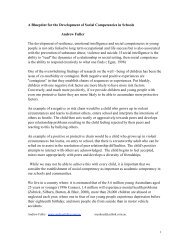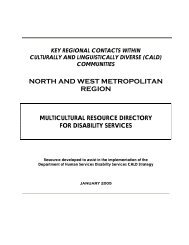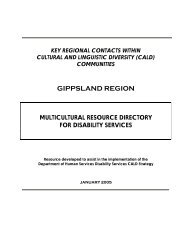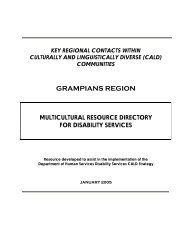Positive Behaviour Support - Department of Human Services - Vic ...
Positive Behaviour Support - Department of Human Services - Vic ...
Positive Behaviour Support - Department of Human Services - Vic ...
Create successful ePaper yourself
Turn your PDF publications into a flip-book with our unique Google optimized e-Paper software.
PowerPoint 92<br />
PowerPoint 93<br />
PowerPoint 94<br />
PowerPoint 95<br />
*<br />
*<br />
*<br />
*<br />
<strong>Positive</strong> behaviour support: Getting it right from the start - Facilitators reference manual 65<br />
Step 3: What message is the person communicating via the behaviour<br />
<strong>of</strong> concern?<br />
<strong>Behaviour</strong>s <strong>of</strong> concern serve a function or purpose for the person. The most common reasons<br />
people show behaviours <strong>of</strong> concern are <strong>of</strong>ten the same as why all people communicate. An<br />
analysis <strong>of</strong> the behavioural recording will have generated some ideas (hypotheses) about the<br />
function <strong>of</strong> the behaviour that is any patterns to the behaviour. Hypotheses regarding the<br />
function or relationship between the behaviour and the individual’s environment can lead to<br />
identifying positive behaviour support strategies. Be aware however that a single behaviour <strong>of</strong><br />
concern may serve more than one function.<br />
The function that a behaviour serves has direct implications for how we respond to the<br />
behaviour. For example it could be decided to ignore a person who is engaging in the behaviour<br />
<strong>of</strong> head banging. In the long term this may lessen the behaviour in a person who head bangs<br />
exclusively to gain social interaction. However the exact same strategy could worsen the<br />
behaviour for another person who bangs because they prefer to stay alone, since this response<br />
may reinforce the behaviour that ‘I bang my head and people leave me alone’.<br />
In the above scenarios both people are communicating through their behaviour, that they would<br />
like more or less attention and it is important to listen to this. However one must try and respond<br />
in a way that is not simply a direct reaction to the head banging.<br />
The following are some <strong>of</strong> the most common messages being communicated via behaviours:<br />
• Gaining social interaction<br />
• Escape or avoidance <strong>of</strong> demands<br />
• Gaining access to preferred activities or tangible objects<br />
• Sensory feedback (e.g. hand flapping, eye poking)<br />
• Pursuit <strong>of</strong> power and control over own life<br />
• Reduction <strong>of</strong> arousal and anxiety.<br />
Analysing the information you have collected using the STAR chart and the MAS; what<br />
messages do you think your focus person is trying to communicate.<br />
Why?<br />
Analyse the STAR charts below, do you agree with the assessment <strong>of</strong> the function <strong>of</strong> the<br />
behaviours identified?<br />
What else could these behaviours be communicating?<br />
Why?












